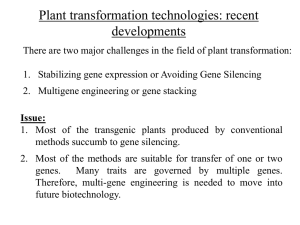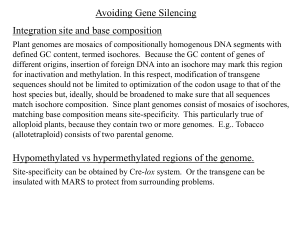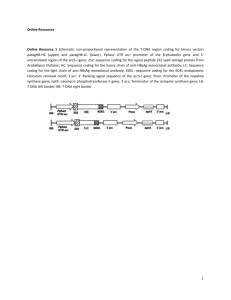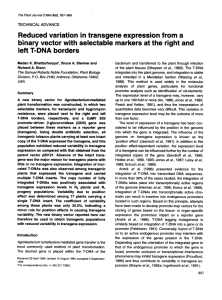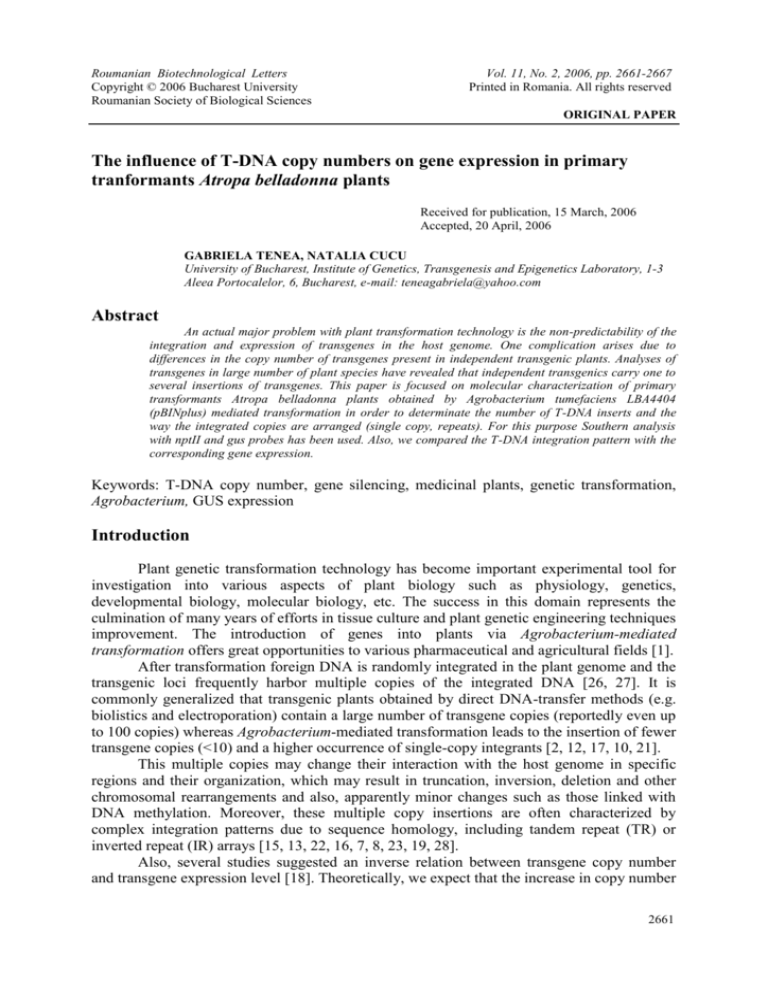
Roumanian Biotechnological Letters
Copyright © 2006 Bucharest University
Roumanian Society of Biological Sciences
Vol. 11, No. 2, 2006, pp. 2661-2667
Printed in Romania. All rights reserved
ORIGINAL PAPER
The influence of T-DNA copy numbers on gene expression in primary
tranformants Atropa belladonna plants
Received for publication, 15 March, 2006
Accepted, 20 April, 2006
GABRIELA TENEA, NATALIA CUCU
University of Bucharest, Institute of Genetics, Transgenesis and Epigenetics Laboratory, 1-3
Aleea Portocalelor, 6, Bucharest, e-mail: teneagabriela@yahoo.com
Abstract
An actual major problem with plant transformation technology is the non-predictability of the
integration and expression of transgenes in the host genome. One complication arises due to
differences in the copy number of transgenes present in independent transgenic plants. Analyses of
transgenes in large number of plant species have revealed that independent transgenics carry one to
several insertions of transgenes. This paper is focused on molecular characterization of primary
transformants Atropa belladonna plants obtained by Agrobacterium tumefaciens LBA4404
(pBINplus) mediated transformation in order to determinate the number of T-DNA inserts and the
way the integrated copies are arranged (single copy, repeats). For this purpose Southern analysis
with nptII and gus probes has been used. Also, we compared the T-DNA integration pattern with the
corresponding gene expression.
Keywords: T-DNA copy number, gene silencing, medicinal plants, genetic transformation,
Agrobacterium, GUS expression
Introduction
Plant genetic transformation technology has become important experimental tool for
investigation into various aspects of plant biology such as physiology, genetics,
developmental biology, molecular biology, etc. The success in this domain represents the
culmination of many years of efforts in tissue culture and plant genetic engineering techniques
improvement. The introduction of genes into plants via Agrobacterium-mediated
transformation offers great opportunities to various pharmaceutical and agricultural fields [1].
After transformation foreign DNA is randomly integrated in the plant genome and the
transgenic loci frequently harbor multiple copies of the integrated DNA [26, 27]. It is
commonly generalized that transgenic plants obtained by direct DNA-transfer methods (e.g.
biolistics and electroporation) contain a large number of transgene copies (reportedly even up
to 100 copies) whereas Agrobacterium-mediated transformation leads to the insertion of fewer
transgene copies (<10) and a higher occurrence of single-copy integrants [2, 12, 17, 10, 21].
This multiple copies may change their interaction with the host genome in specific
regions and their organization, which may result in truncation, inversion, deletion and other
chromosomal rearrangements and also, apparently minor changes such as those linked with
DNA methylation. Moreover, these multiple copy insertions are often characterized by
complex integration patterns due to sequence homology, including tandem repeat (TR) or
inverted repeat (IR) arrays [15, 13, 22, 16, 7, 8, 23, 19, 28].
Also, several studies suggested an inverse relation between transgene copy number
and transgene expression level [18]. Theoretically, we expect that the increase in copy number
2661
GABRIELA TENEA, NATALIA CUCU
would conduct to an increase in transgene expression, as more copies of the DNA yield more
transcripts. This are sometimes the cases of the posttranscriptional control of gene expression
reported by Gendloff et al., (1999) who demonstrated in their run on transcript studies, the
direct relationship between the RNA concentration and gene expression, up to the RNA
turnover value. However, the multiple copy integration patterns such as TR [22, 16, 28] and
IR structures [13, 8, 23, 19] are often associated with low-level transgene expression due to
the transcriptional level of gene silencing.
The interaction of transgene with the host gene sequences at the post transcriptional
level, could be an important factor leading to co-suppression phenomena observed with the
obtaining the GMOs resistant to certain viruses. Also, the literature is abundant with examples
of variable expression level of single copy transgene, which are associated with the
heterochromatic state of the integration genome sites. The same transcriptional DNA
methylation based processes are assumed to be involved in these cases which may be linked
with the type of explants used. Based on these conditions, is necessary to generate a large
number of independent transgenics to find “true” effects of transgene and to eliminate
unrelated, associated effects. Also, it’s important to select the plants that contain just one
single copy of transgenes, called “elite transgene inserts”. Such transgenic plant with a single
transgene copy is less prone to the defense mechanism of silencing than plants with multiple
copy of transgene. Therefore their segregation pattern is elementary and also the homozygous
plants can be easily obtained in these conditions.
This study is concerned on the analysis of primary belladonna transformants (R0) in
order to identify the T-DNA inserts pattern (T-DNA copy number) after their transfer into
plant genome mediated by Agrobacterium in correlation with marker/reporter gene
expression. Southern analysis with nptII and gus probes of the selected primary transformants,
which may give us information about T-DNA integration and T-DNA inserts pattern has been
correlated with the certain variation of gene expression.
Materials and methods
Obtaining of primary transformant Atropa belladonna plants
The techniques for obtaining the Atropa belladonna transgenic plants and maintaining
as an “in vitro” culture has been performed by an indirect (Agrobacterium mediated) method
described in a previously published paper [24, 4, 25]. Atropa belladonna var. nigra plantlets
were obtained by in vitro micropropagation of plantlets derived from sterilized seeds, kindly
provided by the Cluj Botanical Gardens. The regeneration of putative transformed shoots
from the infected tissue has been performed as described earlier [24]. The Agrobacterium
tumefaciens LBA4404 (pBIN plus) strain, kindly provided by Dr. David Tepfer, INRA,
France, has been used. Its binary plasmid vector pBIN plus contained a marker gene, nptII,
under the control of Pnos promoter and a reporter gene, gus, controlled by the P35S promoter.
Characterization of primary transformants (R0)
Molecular characterization of belladonna transgenic plants has been previously done
by genotype (DNA level) and phenotype (protein level) [25, 4] analysis.
Determination of NPTII activity (SDS-PAGE assays)
The expression of the nptII marker gene as its corresponding NPT II polypeptide has
been estimated by the detection of the native 59 kDa dimmer into the total protein extract
obtained from the regenerated shoots. Usually this method is applied for different tissue types
(shoots, calli, roots or tubers) in order to detect certain monomerisation processes, which may
have important effects upon the enzyme activity [25, 4].
2662
Roum. Biotechnol. Lett., Vol. 11, No. 2, 2661-2667 (2006)
The influence of T-DNA copy numbers on gene expression in primary tranformants Atropa belladonna plants
Determination of GUS activity y (fluorimetric assays)
In previous studies [25] we have investigated the GUS activity in some belladonna
primary transformants. This analysis was based on the ability of β-glucuronidase (GUS) to
cleave the substrate 4-methylumbelipheril-β-glucuronidase (4-MUG). Two or three weeks
after regeneration plantlets from calli, leaves were harvested and ground in 100μl buffer
containing 50mM Na2H2PO4, 10mM EDTA, 0,1% Triton-X, 0,1% SDS, 10mM βmercaptoethanol. The mixture was centrifuged twice at 15,000xg at 40C to remove the
insoluble material. 1mM MUG in 0,2M Na bicarbonate was added to mixture and the final
solution was incubated at 370C for 120min. The visualization has been performed directly in
tube on transilluminator at 365nm [14]. Also, the GUS activity was express as a U of
GUS/mgl-1 protein.
Determination of T-DNA pattern by Southern blot analysis
Southern blot analysis was performed to establish the copy number and integration
patterns of the T-DNAs inserted in the genome of the primary transgenic plants.
Leaf material of R0 transformants was collected and used for DNA extraction. Total
DNA was isolated from 6 transgenic belladonna plants (A.b.3.2; A.b.4.7; A.b.9.4; A.b.3.1;
A.b.4.9; A.b.10.1) according to method described by Doyle and Doyle, 1990 [9].
Subsequently, 5 g total DNA was digested with 3U EcoRV enzyme subjected to
electrophoresis and blotted on a Hybond-N membrane (Roche Diagnostics, Basel,
Switzerland). Probe DNA was labeled with fluorescein-dUTP using a random-primed
labeling kit (Gene IMAGE Random Prime Labeling Module) and Taq DNA polymerase [6].
Prehybridization was carried out at 68°C (1h). After overnight hybridization at 68°C the blots
were washed twice at 68°C with two washing solution-containing 25xSSC, 20% SDS and
nanopure H2O. The filters were after words incubated at 22°C in the provided kit blocking
solution. A conjugate solution with anti-fluorescein (AP) (Amersham Pharmacia Biotech) was
used for detection. Total DNA of non-transgenic belladonna plants was included as a negative
control. Restriction enzymes and probes were designed to enable identification of specific TDNA integration patterns (Figure 2).
Results and discussions
In this study we describe a widely used strategy for molecular characterization and
selection of the “elite transgenic insert” based on the level of marker nptII and gus gene
expression and also on the Southern blotting determination on the T-DNA copy number.
Protein assays: NPTII and GUS
A previous paper reported the catalytic activity of the NPTII by both “in vitro” (i.e., its
detoxifying ability of a kanamycin containing medium) and molecular (fractionation by
electrophoresis) methods (data not show). These results were performed in order to elucidate
eventual posttranslational modification of the protein folding which might have had dramatic
effects upon its catalytic activity. Both the “in vitro” and the molecular approaches were used
for a correct analysis in order to prove a high transformation efficiency [3, 4].
In the other hand, when considering the GUS expression, we observed an inter
transformants variation of transgene expression (data not show), within plants transformed
with the same transgene construct and the same condition [3]. In present paper, we quantified
the GUS activity of 25 primary belladonna transformants and approximately we observed the
following pattern of gene expression: 50% (13 out of 25) from these lines exhibited a very
week GUS activity (<500 U GUS/mgl-1 protein), 16,66% (4 out of 25) demonstrating
Roum. Biotechnol. Lett., Vol. 11, No. 2, 2661-2667 (2006)
2663
GABRIELA TENEA, NATALIA CUCU
moderate activity (>501-2500U GUS/mgl-1 protein) and 33,33% (8 out of 25) exhibit higher
GUS activity (>2500U GUS/mgl-1 protein) (figure 1.).
We suggest that this various gene expression depend on T-DNA copy numbers, which
is subsequently analyzed by Southern assays.
A.b.4.9
A.b.3.1
A.b.10.1
number of plants
A.b.9.4
A.b.4.7
3000
2500
2000
1500
1000
500
0
A.b.3.2
U GUS/mg/l proteina
U GUS/mg/l
proteina
Figure 1. Distribution of GUS expression between selected belladonna primary transformants. Abbreviation:
A.b.3.2 A.b.4.7-high GUS expression; A.b.9.4 A.b.3.1-moderate GUS expression; A.b.4.9 A.b.10.1-weak GUS
expression
Southern assays
Southern blot assay has been done for determination of the copy T-DNA inserts in
belladonna genome and the interpretation of the results is given in Table 1. Any specific band
has been verified with non-transformant genomic DNA restricted with the same EcoRV
enzyme and hybridized with the same probes.
Proper interpretation of the Southern blots proved difficult due to the high copy
number and complexity of the T-DNA integration patterns. As such the results given in Table
1 reflect the probable T-DNA copy number and integration patterns. Southern blot analysis of
the A.b.3.2 and A.b.4.7 transformants revealed single copy integration patterns of the T-DNA,
which explain the corresponding high GUS gene expression (figure 1). Southern blot analysis
of the A.b.9.4, A.b.3.1 and A.b.10.1 transformants revealed multiple copy inserts (figure 2).
In similar cases, the literature suggests some numerous factors implicated in gene expression
variation, such as the heterochromatic nature of the integration in genome region, the
arrangement (TR/IR) of the copies. It is assumed also in many cases that vector DNA was
integrated too [6].
2664
Roum. Biotechnol. Lett., Vol. 11, No. 2, 2661-2667 (2006)
The influence of T-DNA copy numbers on gene expression in primary tranformants Atropa belladonna plants
Table 1.
NPTII
probe
Southern blot
Pattern
nptII probe
1 fragment: Single copy
1 fragment: Single copy
2 fragment: multiple copy
2 fragments: Complex:
multiple copy
>4 fragments: Complex:
multiple copy
>4 fragments: Complex:
multiple copy
M
A.b.3.1
A.b.4.7
A.b.9.4
A.b.3.2
A.b.10.1
A.b.3.1
A.b.4.9
A.b.10.1
N
A.b.4.9
N
A.b.3.2
A.b.4.7
A.b.9.4
A.b.3.1
N
Southern blot
Pattern
Gus probe
1 fragment: Single copy
1 fragment: Single copy
4 fragments: Complex:
multiple copy
>4 fragments: Complex:
multiple copy
>4 fragments: Complex:
multiple copy
>4 fragments: Complex:
multiple copy
A.b.4.9
A.b.10.1
Samples
(DNA from transgenic
belladonna leaves)
A.b.3.2
A.b.4.7
A.b.9.4
GUS
probe
Figure 2. Southern analysis of primary belladonna transformants using nptII and gus probes
Conclusion
In this study we investigated the impact of the T-DNA copy number on variability of
transgene expression in belladonna primary transformants by correlating the results of both
protein and DNA (Southern) assays. Our results showed that a simple strategy for
transformation A.belladonna plants with a simple construct (with marker and reporter genes)
using Agrobacterium as gene transfer system had influenced the gene expression and T-DNA
integration pattern. The transgene copy numbers may be highly variable depending on the
transformation method. A high frequency of increased T-DNA copy number is observed with
biolistic methods as compared with the indirect, Agrobacterium mediated, ones. Our results
showed however a variation of such copy number even through a mediated method, which
may suggest the involvement of certain other factors, not yet clarified that control the gene
Roum. Biotechnol. Lett., Vol. 11, No. 2, 2661-2667 (2006)
2665
GABRIELA TENEA, NATALIA CUCU
transformation process. Common to all transformation methods in use is that multiple copies
tend to integrate in one or a few insertion sites, probably as a result of extra-chromosomal
ligation of the transgenic DNA fragments before integration [5, 6, 20].
This factor determines the explanation of the variation of transgene expression by TDNA copy number of the integrated transgenes. Therefore, in order to obtain more predictable
transgene expression levels, single-copy transformants are often preferred and selected as elite
transgenes. It is clear that predictable transgene expression level requires further optimization
of transformation strategies. Based of knowledge of the molecular mechanisms of the
variation of gene expression in these cases, new technologies are being developed to increase
the frequency of single-copy transgene integration. The research activities are focused further
on targeting of foreign genes in plant genome into a predetermined chromosomal site
achieved by homologous recombination using enzymes from another eukaryote systems (such
as bacteria and yeasts) or by induction of double-strand breaks in target DNA.
Acknowledgement
This research represents the Gabriela Tenea activity during PhD training programme and part
of this analysis has been done during Marie Curie Training fellowship (2003-2004). The
authors thank MRIII Calin Alexandrina for technical support.
References
1. BHAT, S.R. & SRINIVASAN, S., 2002 Molecular and genetic analyses of transgenic
plants: Considerations and approaches. Plant Sci. 164: 673-681.
2. Butaye, K.J.M., Goderis, I.J.W.M., Wouters, P.F.J., Pues, J.M.-T.G., Delauré, S.L.,
Broekaert, W.F., Depicker, A., Cammune, B.P.A. & De Bolle, M.F.C. (2004) Stable highlevel transgene expression in Arabidopsis thaliana using gene silencing mutants and matrix
attachment regions. Plant J. 39: 440-449.
3. CUCU N., G.NEGOIANU-TENEA, GAVRILA L, 2002 Genetically modified medicinal
plants II. Transfer and expression of a marker kanamycine resistance gene in Atropa
belladonna plants, Roumanian Biotechnological Letters, 7 (4); 869-864.
4. CUCU N., TENEA G, GAVRILA L., 2003, Transfer and expression of marker (nptII) and
reporter (gus) genes in Atropa belladonna plants, Bioteh & Biotech Equipment, 1 (8), 143-151.
5. DE BLOCK, M. & DEBROUWER, D., 1991, Two T-DNA's co-transformed into Brassica
napus by a double Agrobacterium tumefaciens infection are mainly integrated at the same
locus. Theor. Appl. Genet. 82: 257-263.
6. DE BUCK S., DE WILDE C., VAN MONTAGU M. AND DEPICKER A., 2000, T-DNA
vector backbone sequences are frequently integrated into the genome of transgenic plants
obtained by Agrobacterium-mediated transformation. Mol. Breed. 6: 459–468.
7. DE NEVE M., DE BUCK S., JACOBS A., VAN MONTAGU M. AND DEPICKER A.,
1997, T-DNA integration patterns in co-transformed plant cells suggest that T-DNA repeats
originate from ligation of separate T-DNAs. Plant J. 11: 15–29.
8. DEPICKER, A. & VAN MONTAGU, M., 1997, Post-transcriptional gene silencing in
plants. Curr. Opin. Cell Biol. 9: 373-382.
9. DOYLE J.J, DOYLE J.L., 1990, Isolation of plant DNA from fresh tissue Focus 12: 13-15.
10. GELVIN, S.B., 2003, Agrobacterium-Mediated Plant Transformation: the Biology behind
the “Gene-Jockeying” Tool. Microbiol. Mol. Biol. Rev. 67: 16-37.
2666
Roum. Biotechnol. Lett., Vol. 11, No. 2, 2661-2667 (2006)
The influence of T-DNA copy numbers on gene expression in primary tranformants Atropa belladonna plants
11. GENDLOFF, E.H., BOWEN, B. & BUCHHOLZ, W.G., 1990, Quantitation of
chloramphenicol acetyl transferase in transgenic tobacco plants by ELISA and correlation
with gene copy number. Plant Mol. Biol. 14: 575-583.
12. HANSEN, G. & WRIGHT, M.S., 1999, Recent advances in the transformation of plants.
Trends Plant Sci. 4: 226-231.
13. HOBBS, S.L.A., WARKETIN, T.D. & DELONG, C.M.O., 1993, Transgene copy number
can be positively or negatively associated with transgene expression. Plant Mol. Biol. 21: 17-26.
14. JERFFERSON R.A., 1987, GUS fusions: beta-glucuronidase as a sensitive and versatile
gene fusion marker in higher plants. EMBO J, 6:3901-3907.
15. JORGENSEN, R., SNYDER, C. & JONES, J.D.G., 1987, T-DNA is organized
predominantly in inverted repeat structures in plants transformed with Agrobacterium
tumefaciens C58 derivatives. Mol. Gen. Genet. 207: 471-477.
16. JORGENSEN, R.A., CLUSTER, P.D., ENGLISH, J., QUE, Q. & NAPOLI, C.A., 1996,
Chalcone synthase co suppression phenotypes in petunia flowers: comparison of sense vs. antisense
constructs and single-copy vs. complex T-DNA sequences. Plant Mol Biol. 31: 957-973.
17. KOPREK, T., RANGEL, S., MCELROY, D., LOUWERSE, J.D., WILLIAMSCARRIER, R.E. & LEMAUX, P.G., 2001, Transposon-mediated single-copy gene delivery
leads to increased transgene expression in barley. Plant Physiol. 125: 1354-1362.
18. KOHLI, A., TWYMAN, R.M., ABRANCHES, R., WEGEL, E., STOGER, E. &
CHRISTOU, P. 2003, Transgene integration, organization and interaction in plants. Plant
Mol. Biol. 52: 247-258.
19. MUSKENS, M.W., VISSERS, A.P., MOL, J.N. & KOOTER, J.M. 2000, Role of inverted
DNA repeats in transcriptional and post-transcriptional gene silencing. Plant Mol. Biol. 43:
243-260.
20. PAWLOWSKI, W.P. & SOMERS, D.A., 1998, Transgenic DNA integrated into the oat
genome is frequently interspersed by host DNA. Proc. Natl. Acad. Sci. U.S.A. 95: 1210612110.
21. REDDY, M.S., DINKINS, R.D. & COLLINS, G.B. 2003, Gene silencing in transgenic
soybean plants transformed via particle bombardment. Plant Cell Rep. 21: 676-683.
22. SIJEN, T., WELLINK, J., HIRIART, J.B. & VAN KAMMEN, A., 1996, RNA-Mediated
Virus Resistance: Role of Repeated Transgenes and Delineation of Targeted Regions. Plant
Cell, 8: 2277-2294.
23. STAM, M., DE BRUIN, R., KENTER, S., VAN DER HOORN, R.A.L., VAN
BLOKLAND, R., MOL J.N.M. & KOOTER, J.M., 1997, Post-transcriptional silencing of
chalcone synthase in Petunia by inverted transgene repeats. Plant J. 1: 63-82.
24. TENEA G, CUCU N., CALIN A., POPA O., L. GAVRILA, 2000, Atropa belladonna in
vitro culture initiation, National Symposium Tissues culture and vegetable cells, 10-11
noiembrie, Cluj-Napoca.
25. TENEA G, CALIN A., CUCU N, 2002, Genetic modified medicinal plants. I.
Agrobacterium tumefaciens mediated reporter gus gene transfer and expression in Atropa
belladonna plants, Roumanian Biotechnological Letters, 7 (3), 773-778.
26. TINLAND B, 1996, The integration of T-DNA into plant genome, Trends in Plant
Science 1(6):178-184.
27. TZFIRA T, LACROIX B, CITOVSKY V, 2004, Agrobacterium T-DNA integration:
molecules and models, Trends in Genetics 20 (8), 375-383.
28. WANG, M.B. & WATERHOUSE, P.M., 2000, High-efficiency silencing of a betaglucuronidase gene in rice is correlated with repetitive transgene structure but is independent
of DNA methylation. Plant Mol. Biol. 43: 67-82.
Roum. Biotechnol. Lett., Vol. 11, No. 2, 2661-2667 (2006)
2667



